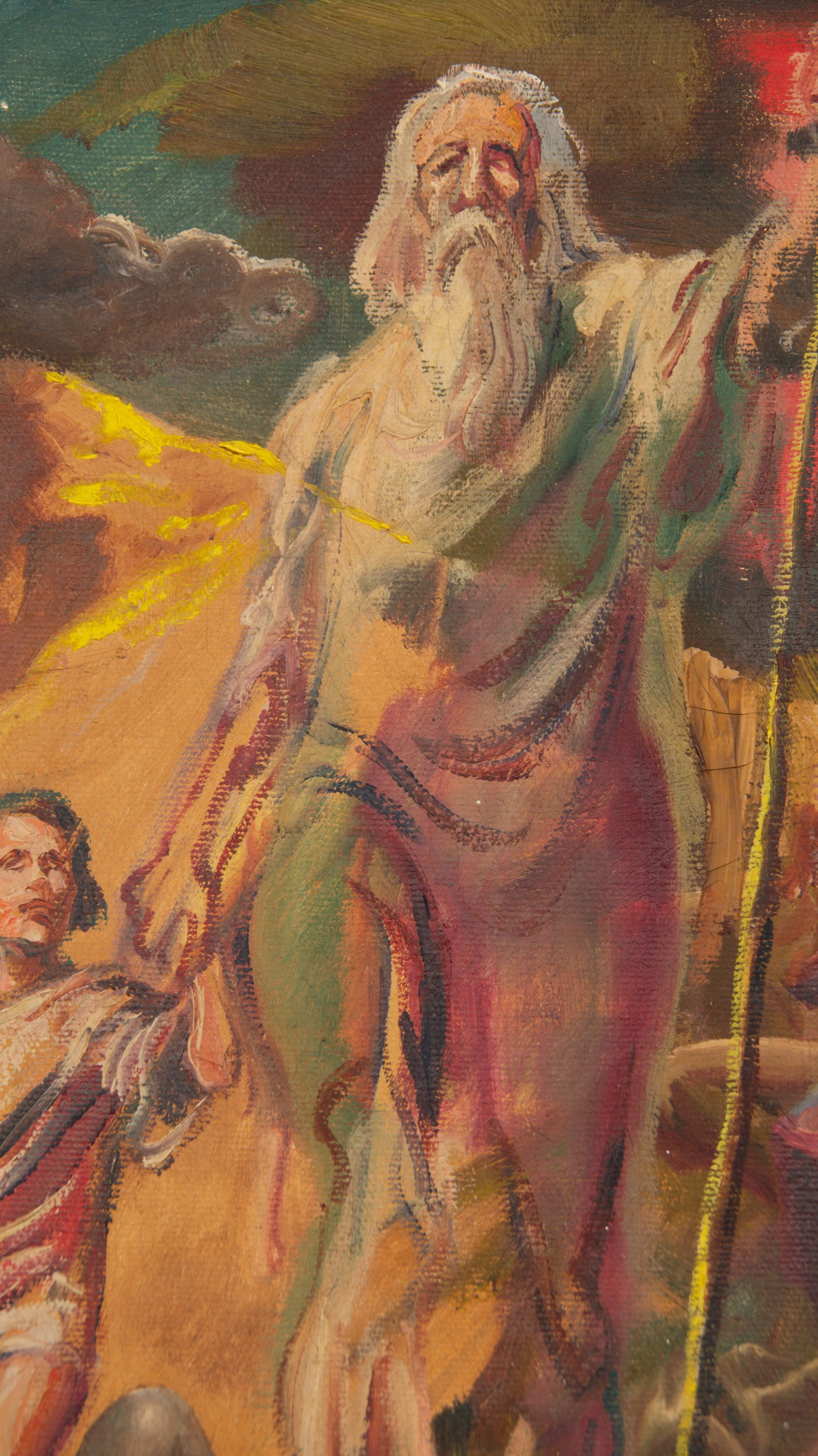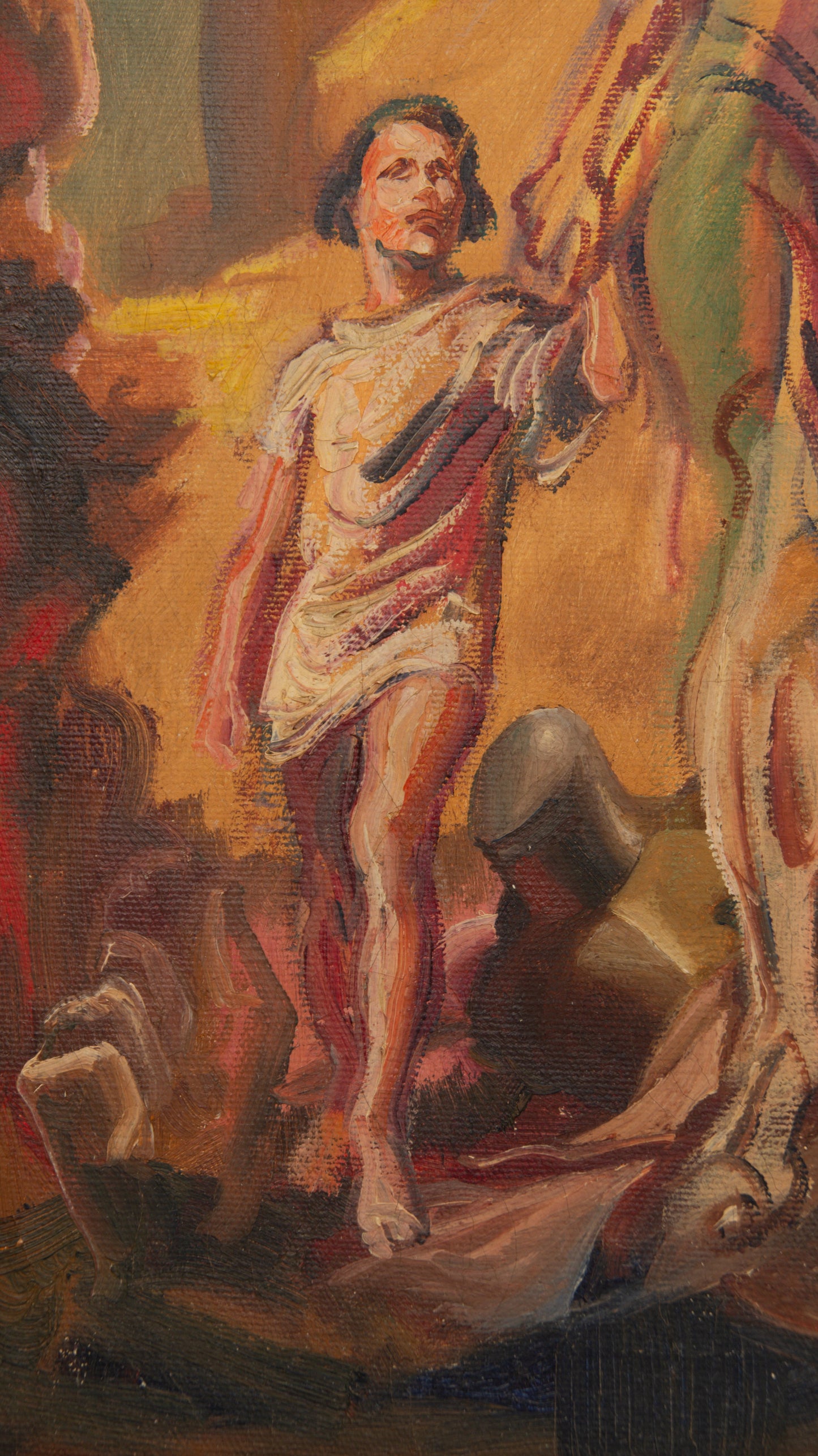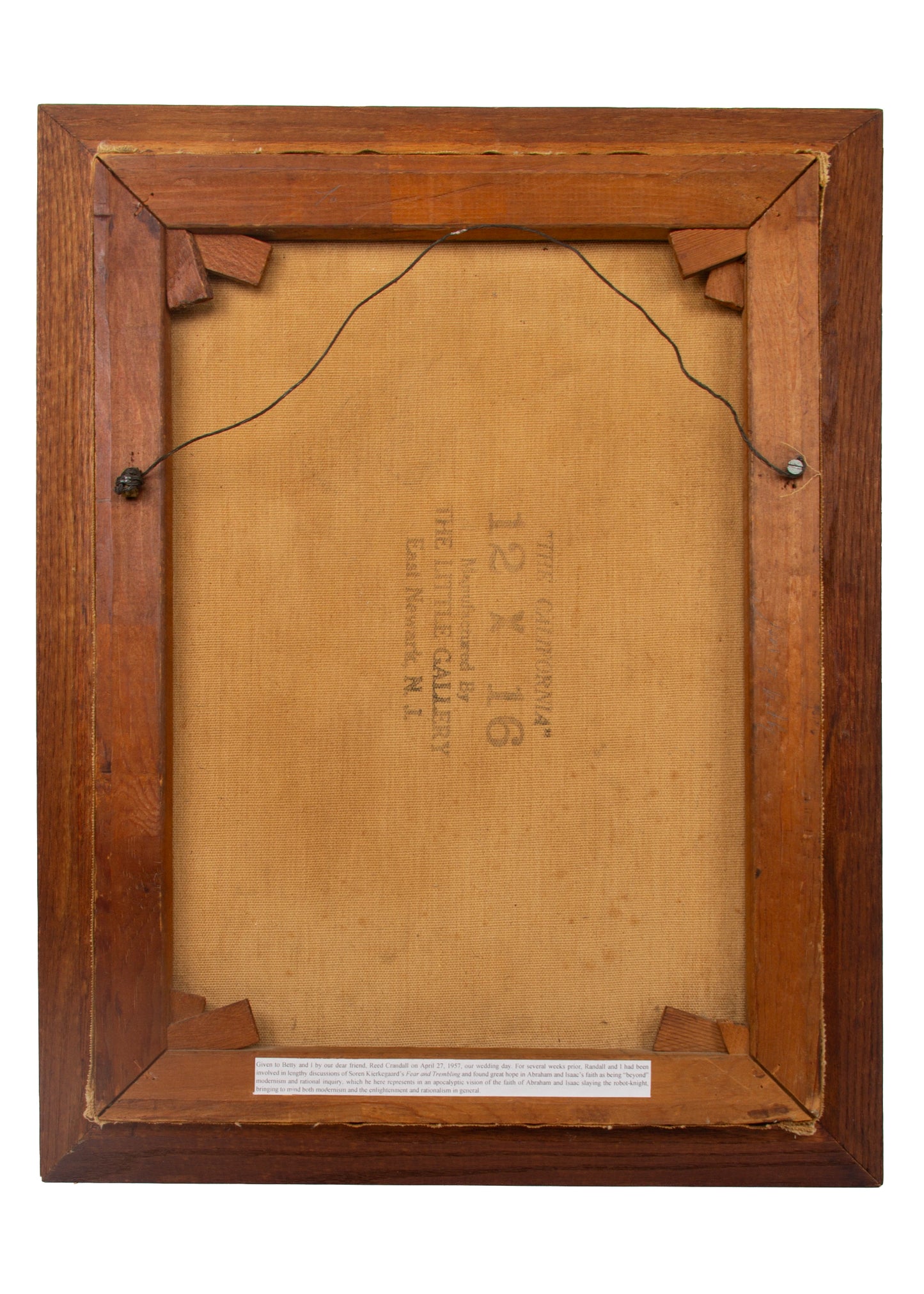Specs Fine Books
1957 REED CRANDALL. Oil on Canvas Illustration Soren Kierkegaard's "Fear and Trembling."
1957 REED CRANDALL. Oil on Canvas Illustration Soren Kierkegaard's "Fear and Trembling."
Couldn't load pickup availability
A wonderful little item which wins our award for the occupying the quirkiest niche corner of this week's cataloguing.
The present work was painted by one of the most influential comic book artists of the 20th century. In 1954, the department of EC Comics he worked for was shut down after a sequence of Congressional Hearings on Juvenile Delinquency. This left Crandall, who would only pop back into the public eye again around 1960, in a serious existential crisis.
It was at this time, already it seems well into his alcoholism, that he met the United Methodist minister, John Farquharson Dow [1930-2019], then pastor and graduate of the Drew and New York Theological Seminary. They began to meet at John's house and took to reading Martin Buber, Reinhold Niebur, and Soren Kierkegaard together. But it was apparently Kierkegaard that occupied most of their time.
In April of 1957, Crandall painted the present for him as a tribute to their weeks together reading Kierkegaard's classic on Abraham and Isaac, Fear and Trembling. It was a gift for Dow's wedding on April 27, 1957.
Before John's death in 2019, he dictated a description of his memory of the painting, attached to the rear stretcher, "Given to Betty and I by our dear friend, Reed Crandall on April 27, 1957, our wedding day. For several weeks prior, Randall [sic.] had been involved in lengthy discussions of Soren Kierkegaard's Fear and Trembling and found great hope in Abraham and Isaac's faith as being 'beyond' modernism and rational inquiry, which he here represents in an apocalyptic vision of the faith of Abraham and Isaac slaying the robot-knight, bringing to mind both modernism and the enlightenment and rationalism in general."
The painting itself measures 12 x 16 inches on "The California" canvas manufactured by The Little Gallery in East Newark, New Jersey. Presented in a simple oak frame, not attached.
The painting is in a very good state with a very minor loss at lower right, left central, and upper left center, each c.1mm. Unsigned, but authenticity unconditionally guaranteed. Purchased directly from the Dow family.
Crandall's illustrations and print media have sold for in excess of $30,000.00.
A wonderfully quirky piece. I love that it grounds one of the great "comic book" illustrators of the 20th century into long evenings spent discussing the nature of faith, doubt, existential crises, and Kierkegaard.
REED CRANDALL BIOGRAPHY:
Reed Crandall (1917 – 1982) was an influential American illustrator and penciller of comic books and magazines. He was best known for the 1940s Quality Comics' Blackhawk and for stories in EC Comics during the 1950s. Crandall was inducted into the Will Eisner Comic Book Hall of Fame in 2009.
Immediately after graduating high school in Winslow, Indiana, Crandall attended the Cleveland School of Art in Cleveland. He graduated in 1939. But his college years were tumultuous. His father died in the spring of freshman year, leading to his mother and sister’s move to Cleveland. During these years, Crandall supported both himself and his family painting signs and storefront windows around Cleveland. It suited him. His early influences had been the paintings and commercial illustrations of N.C. Wyeth, Howard Pyle and James Montgomery Flagg.
After a string of short-term jobs as an illustrator, he moved to New York with his mother and sister and found work in the then-fledgling medium of comic books.
Crandall drew for comic books from 1939 until 1973. His first work appears in comics from publisher Quality Comics, for which he drew stories starring such superheroes as the Ray (in Smash Comics, beginning in 1941 and initially under the playful pseudonym E. Lectron) and Doll Man (first in Feature Comics in 1941, then in the character's own solo title). His earliest confirmed cover art is for Fiction House's Fight Comics #12 (April 1941) at the Grand Comics Database. Other early work includes inking the pencil art of future industry legend Jack Kirby on two of the earliest Captain America stories, "The Ageless Orientals That Wouldn't Die", in Captain America Comics #2 (April 1941), and "The Queer Case of the Murdering Butterfly and the Ancient Mummies" in #3 (May 1941).
With S.M. "Jerry" Iger credited as writer, Crandall co-created the superhero the Firebrand in Quality's Police Comics #1 (Aug. 1941) and began his long run as artist of his signature series, the World War II aviator-team strip "Blackhawk", in Military Comics #12-22 (Oct. 1942 - Sept. 1943) and, after his WWII service in the Army Air Force, in Blackhawk and in Modern Comics. During this time he also drew the adventures of Captain Triumph in Quality's Crack Comics. His final "Blackhawk" work was a seven-page story, plus the cover, for Blackhawk #67 (Aug. 1953).
Crandall went on to become a mainstay of EC Comics, whose line of hit horror and science fiction titles would become as influential to future generations of comics creators as they were controversial in their own time due to their often-graphic nature and mature themes. Joining a group that included artists Johnny Craig, Jack Davis, Will Elder, Frank Frazetta, Graham Ingels, Jack Kamen, Bernard Krigstein and Wally Wood, Crandall made his debut there with the six-page story "Bloody Sure", written by Al Feldstein, in The Haunt of Fear #20 (August 1953).
He drew dozens of stories across a variety of genres for the EC anthologies Crime SuspenStories, Shock SuspenStories, Tales from the Crypt, Two-Fisted Tales, The Vault of Horror, Extra!, Impact, Piracy, and Weird Fantasy and its sequel series, Weird Science-Fantasy.
Following the demise of EC in the wake of the 1954 U.S. Senate hearings on juvenile delinquency and a wave of anti-comics sentiment, Reed freelanced for Atlas Comics, the 1950s iteration of Marvel Comics, as well as for the Gilberton Company's Classics Illustrated. Crandall's work for Classics Illustrated consisted of joint projects with EC veteran George Evans on four titles: No. 18, The Hunchback of Notre Dame (Fall 1960); No. 23, Oliver Twist (Fall 1961); No. 68, Julius Caesar (1962); No. 168, In Freedom's Cause (completed 1962; published UK 1963; published US 1969).
In 1960, he went under contract with the publisher of Treasure Chest, a comic book distributed exclusively through parochial schools. Crandall illustrated many covers and countless stories for Treasure Chest through 1972. In 1964, he illustrated books by Edgar Rice Burroughs for Canaveral Press. The following year, he began contributing to Warren Publishing's black-and-white war-comics magazine Blazing Combat, and soon went on to contribute to the company's line of black-and-white horror publications, including Creepy and Eerie. In the mid-to-late 1960s, he illustrated superhero-espionage stories for Tower Comics, and space opera science fiction in King Features Syndicate's King Comics comic-book version of the syndicate's long-running hero Flash Gordon.
In June 1970, Crandall and Buster Crabbe were guests at the Multicon-70 convention in Oklahoma City.
Crandall, who had left New York City in the 1960s in order to care for his ailing mother in Wichita, Kansas, had developed alcoholism. Recovering by the time of his mother's death, he nonetheless suffered debilitated health and left art in 1974 to work as a night watchman and janitor for the Pizza Hut general headquarters in Wichita. After suffering a stroke that year, he spent his remaining life in a nursing home and died in 1982 of a heart attack. One of his last published stories, "This Graveyard Is Not Deserted", appeared in Creepy #54 (July 1973). Creepy #58 contained "Soul and Shadow", possibly his last published comic book work.
Crandall was inducted into the Will Eisner Comic Book Hall of Fame in 2009.
Share








